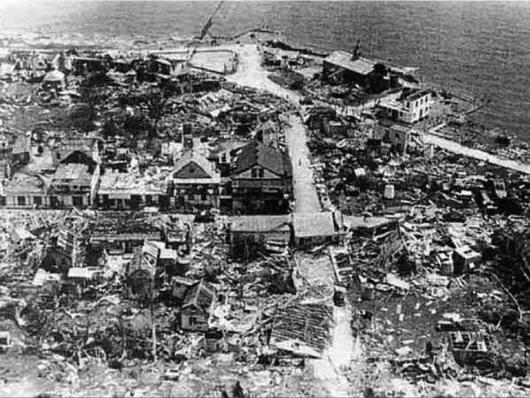Origin Of Hurricane Janet:
Hurricane Janet originated as a tropical wave off the coast of West Africa, moving westward across the Atlantic Ocean. It officially became a tropical storm on September 21, 1955, east of the Lesser Antilles.
As it traveled through the warm waters of the Caribbean Sea, Janet rapidly intensified. By September 22, it had reached hurricane strength, and over the next few days, it grew into a Category 5 hurricane, the highest level on the Saffir-Simpson scale with sustained winds of 175 mph (280 km/h). Janet’s path took it across the Caribbean, where it caused destruction in the Windward Islands, especially Barbados and the Grenadines, before heading toward the Yucatán Peninsula. On September 28, it made landfall near Chetumal, Mexico, just north of Corozal Town in British Honduras (now Belize).
This landfall marked a historic moment: Janet was the first recorded Category 5 hurricane to strike a continental mainland in the Atlantic basin. Its origin and rapid intensification were driven by favorable conditions, warm sea surface temperatures, low wind shear, and a well-organized core.
The Impacts of Hurricane Janet:
1. Severe Damage
Corozal Town was 90% destroyed. More than 16,000 people were left homeless. Houses, schools, and crops were flattened. The sugar industry suffered greatly.
Corozal — worst hit (extreme destruction, over 90% of the town damaged).
Orange Walk — damaged crops, strong winds.
Other areas felt effects but no major destruction.
2. Loss of Lives and Livelihood
Many people were killed or injured. Farms were flooded, and animals were lost. Families lost their homes, food, and belongings.
3. Emotional and Social Effects
People were left in shock, grief, and fear. Many families were separated or displaced.
4. Libertad Village, Corozal District : Home to one of Belize’s main sugar factories at the time
- Hurricane Janet hit Libertad very hard in 1955.
- Sugarcane fields were destroyed, so there was no cane to crush.
- The factory building and machines were damaged by strong winds and rain.
- The factory had to stop working for a while after the storm.
- Many workers lost jobs or had no work because there was no cane.
- After the storm, the factory never fully recovered.
- The Libertad Sugar Factory was closed down in the early 1980s.
The response and relief efforts for Hurricane Janet in Belize included:
- British Government Response: The British government provided £40,000 (approximately US$110,000 at the time) in relief funds to support the affected areas in Belize.
- Jamaican Government Response: The Jamaican government contributed £20,000 (approximately US$55,000) to the relief efforts.
- US Response: The United States sent the cargo ship USS Antares with relief materials to support the affected areas.
- Reconstruction Program: A large-scale reconstruction program was initiated by the government to rebuild 48 villages that were severely damaged or destroyed by the hurricane.
These efforts aimed to provide immediate relief and support the long-term recovery of the affected communities.
Survivor Accounts from Corozal
Ambergris Caye forums capture vivid recollections from those who lived through Janet:
Aida Garcia (age 27 at the time) sheltered at a distillery with her husband and four young children. She recalls:
“Around midnight the ceiling of the building blew away… Mr. Garcia overturned vats…and put his wife and children in them. … They spent the rest of the hurricane inside those vats.”
Maria Gomez (age ~12) sheltered with family at town hall. She remembers hearing walls crack and having to drink muddy water after fresh water ran out. Once home, they discovered their house was gone—her father wept at the sight.
Carmita Garcia (age 10) was blown about six miles by the winds into a tree trunk and survived only to be found seven days later. She remembers being cared for by “an old man with a big hat,” and credits bush medicine for her recovery.
Such stories illustrate the terror, randomness, and miraculous moments of survival for ordinary families.

Conclusion
Though Hurricane Janet left behind a path of unimaginable destruction, it also revealed the strength, unity, and spirit of our people. In the face of devastation, communities rebuilt with courage, determination, and hope. Let this page serve not only as a record of history but as a testament to the resilience of Belizeans — a reminder that even in our darkest hours, we rise, we rebuild, and we remember

